|
The Artifact Evidence OOPARTS |
|
Mystery of the Lady of Elche:
Atlantean Goddess Figure 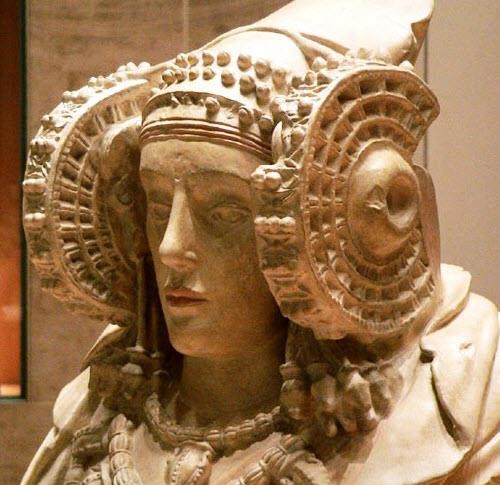 What has wrongly been labeled as hair is actually a form of unknown technology which has been fitted to this figures head. Earth Ancients From Earth Ancients
The origin of this sculpture has sparked lively debate. The stone bust that was discovered by chance in 1897 at L'Alcúdia, an archaeological site on a private estate about two kilometers south of Valencia, Spain. The Lady of Elche is generally believed to be a piece of Iberian sculpture from the 4th century BC, though the artisanship suggests strong Hellenistic influences. The problem with this dating, is the fact that there are no similar sculptures from that time period that even come close to the high degree of execution, which leaves the debate open that the work comes from a much earlier period. A number of independent scholars have indicated that the work is of an early Atlantean Goddess, and the refined face is characterized as uniquely Caucasian. It should also be brought to the viewer attention that there are a number of fascinating elements to this sculpture that throw it into the level of anomalous works and not of a period considered from our historic perspective. 1. Integrated Technology - what was once considered huge spools of hair, on each side of the head of the Lady of Elche, are actually massive headgear of some type which connects at the back of the head and is supported by the neck and side of the head. Edgar Casey, in his readings, describes the Atlantis culture as highly advanced and in possession of technology which was used to transport people effortlessly to any place on Earth. Perhaps this is one of these devices. It’s very hard to speculate on this – as we have no references to this ancient technology – and if this was a sculpture fashioned in the image of a Goddess – then what she wears could be from a period in Atlantean history where people integrated technology into their everyday activities. 2. Unusual Anatomy – one of the most interesting features in the sculpture is the protrusion of a large and significantly elongated skull. I hadn’t notice this until I viewed a profile of the sculpture, and small version of the Dama de Elche, (considered a similar Goddess.) In many examples, these figures have elongated heads – which are hidden from view under headdresses. Does this mean that a portion of the Altantean culture were longheads? We just don’t know – but this sculpture of the Lady of Elche is remarkable, and may create a new wave of speculation in where the Peruvian, Mayan and other elongated head people originated. It should be noted that we have identified the original architects of Cusco, Sacsayhuman and other ancient cities in and around Peru and highlight this information in Earth Ancients. SOURCE 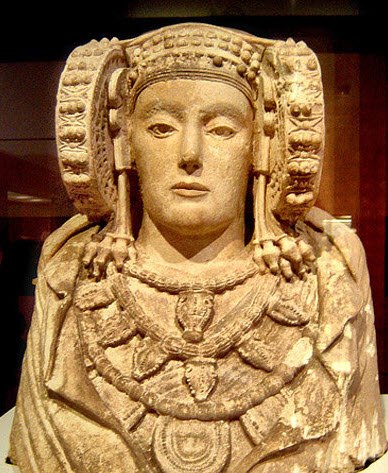 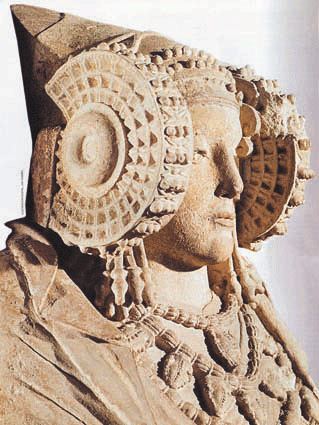 In the photo we can see the cone shaped headdress that the figure is wearing to protect her head. 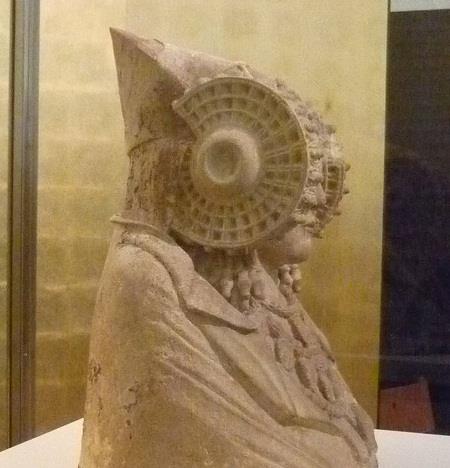 This side view of the head device clearly shows that its neck attachment supports and balances the weight of the technology. 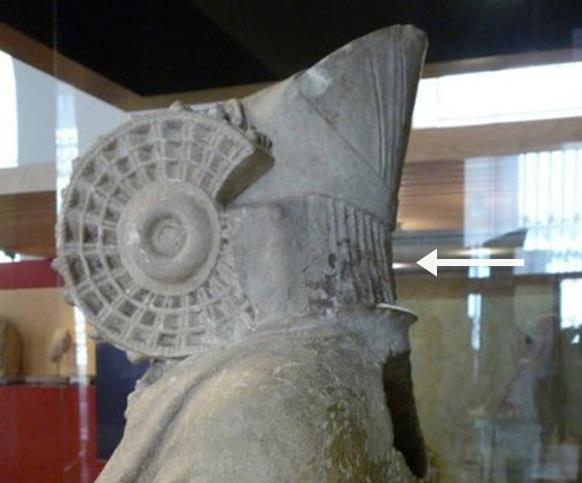 Whatever this device was used for - it's clear that it was worn as a complete apparatus which was engaged by its user in some integral manner. 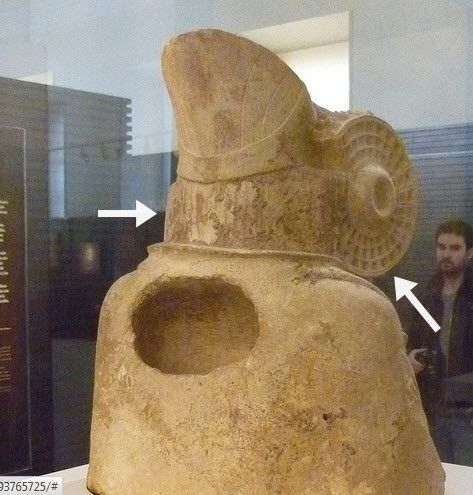 This photo reveals the sheer size of the device and how it connects with the head. |
Lady of Elche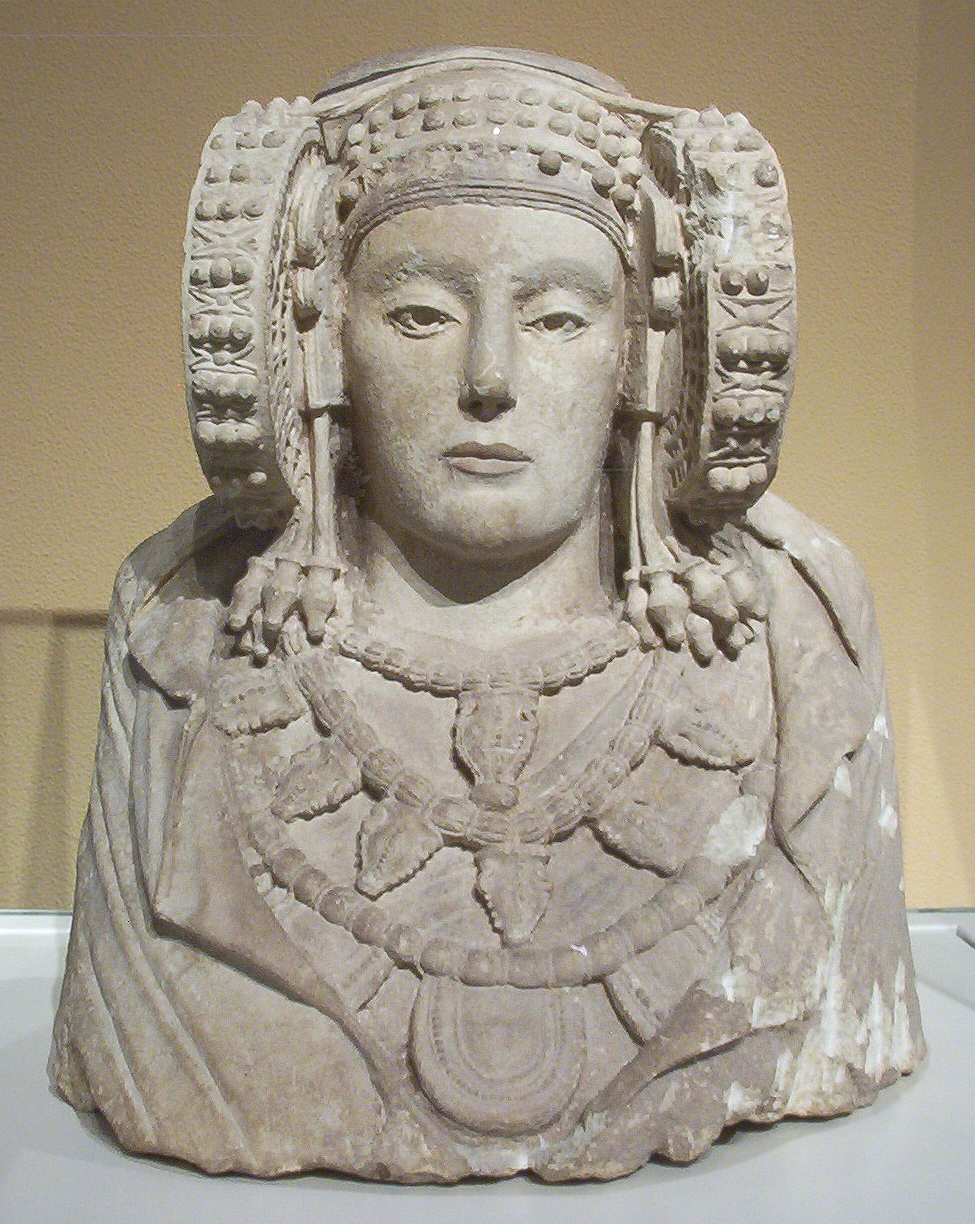 The Lady of Elche or Lady of Elx (Spanish: Dama de Elche, IPA: [ˈdama ðe ˈeltʃe]; Valencian: Dama d'Elx, IPA: [ˈdama ˈðɛʎtʃ]) is a polychrome stone bust that was discovered in 1897 at L'Alcúdia, an archaeological site on a private estate two kilometers south of Elx/Elche, Alicante, Spain. The Lady of Elche is generally known as an Iberian sculpture from the 4th century BC, although the artisanship suggests strong Hellenistic influences. According to The Encyclopedia of Religion, the Lady of Elche (Roman Illici), is believed to have a direct association with Tanit, the goddess of Carthage, who was worshiped by the Punic-Iberians. Sculpture The originally polychrome bust is usually thought to represent a woman wearing a complex headdress and large wheel-like coils (known as rodetes) on each side of the face. The aperture in the rear of the sculpture indicates it may have been used as a funerary urn.  Detail of the Lady of Elche
The Lady of Guardamar is a closely similar female bust, 50 cm high, also dated circa 400 BCE, that was discovered in fragments in the Phoenician archaeological site of Cabezo Lucero in Guardamar del Segura in Alicante province, Spain, in 1987. The Lady of Guardamar has similar wheel-like rodetes and necklaces. While it is a bust, there are proposals that it was part of a seated statue akin to the Lady of Baza or a standing one like the Gran Dama Oferente from Cerro de los Santos (Montealegre del Castillo, Albacete). The necklaces with their pendants are similar to those found on the Lady of Baza, discovered about 130 miles to the south west. The three figures and the Bicha of Balazote are exhibited in the same hall in the National Archaeological Museum of Spain in Madrid. Discovery and Repatriation Color reconstruction by Francisco Vives The sculpture was found in August 4, 1897 by a young worker, Manuel Campello Esclapez. This "popular" version of the story differs from the official report by Pere Ibarra (the local keeper of the records) which stated that Antonio Maciá found the bust. His version has farm workers who were clearing the southeast slope of the hill of La Alcudia, for agricultural purposes discovering the sculpture. Where the bust of Elche was discovered is now an archaeological site. Evidence has been found of an Iberian-Punic settlement, a Roman sewer, walls and Roman houses, and mosaics, including a mosaic and a lamp with an effigy of Saint Abdon, belonging to a Christian basilica who It of the 5th century. The latter archaeological evidence is supported by the codices of the councils of Toledo where it talk about an audience with bishops from Illici (Elche). Pierre Paris, a French archaeological connoisseur, purchased the sculpture within a few weeks and shipped it to France, where it was shown at the Louvre Museum and hidden for safe-keeping during World War II. The Vichy government negotiated with Franco's government its return to Spain in 1940–41, and on June 27, 1941 the sculpture was placed in the Museo del Prado (Madrid), then moved to the National Archaeological Museum, where it remains. The discovery of the Lady of Elche initiated a popular interest in pre-Roman Iberian culture. She appeared on a 1948 Spanish one-peseta banknote and was mentioned in William Gaddis's The Recognitions (1955). The sculpture was temporarily on display from May 18 to November 1, 2006 at the Museo Arqueológico y de Historia de Elche, where it is now represented by a replica. 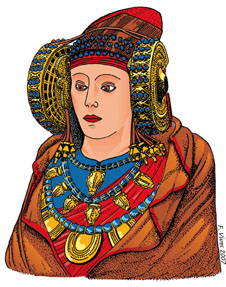 Color reconstruction by Francisco Vives SOURCE: Wikipedia
|
|
Lady of Guardamar Lady of Guardamar (Dama de
Guardamar), also known as the Lady of Cabezo Lucero, is a limestone
female bust, 50 cm high, dated circa 400 BCE, that was discovered in
fragments in the Phoenician archaeological site of Cabezo Lucero in
Guardamar del Segura in Alicante province, Spain, on September 22, 1987.
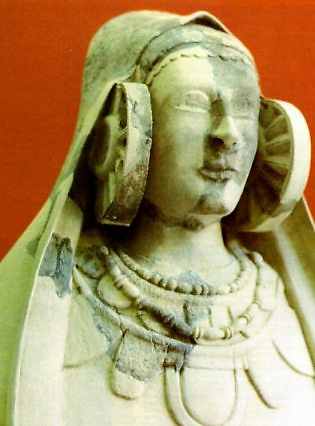 Cabezolucerodama
A large piece of a stone rodete (wheel headgear) was
found first, at a shallow depth. There followed other fragments of the
bust of an Iberian lady, and one large piece included the headdress,
face and neck, which were found to have similarities to the Iberian
bust, Lady of Elche. The sculpture had been hammered to fragments and
even burnt in places. These fragments were taken to the laboratory of
the Provincial Archaeological Museum of Alicante, where restorer Vincent
Bernabeu began with washing and identifying the bits, first the chin,
then the lips, then collar and chest pieces, and many other fragments
that did not fit together and were not part of the carved surface. The
delicate and painstaking task of restoration began in October 1987 and
was completed in June 1988.The restored sculpture is of fine-grained greyish limestone. The Lady is wearing a tunic with a round neckline. A scalloped headband crosses the brow and connects the rodetes, which represent hollow wheels, probably of thin metal, on each side. Above the headband and rodetes the Lady wears a mantle with finely carved drapery details. The necklaces the Lady wears are each different; one is composed of seven bullae which are all the same except for the central one, which is grooved. Below it is another necklace that has larger bullae, some shaped like curved triangles and some semicircular at the bottom. The string of beads worn second from the neck has olive-shaped, spherical and flat beads, above it is a string of spherical beads with two plates at the center. In real life these beads would have been made of glassy paste, as such beads often appeared in the Albufereta excavation. In style the Lady of Guardamar is a bit more archaic than the other contemporary Iberian sculptures Lady of Baza or the Lady of Elche, with features more Iberian. As nothing from the site is more recent than 300 BCE, and the site flourished between 430 and 350 BCE, it seems likely that the Lady dates from 400 to 370 BCE. SOURCE: Wikipedia |
| FAIR USE NOTICE: This page contains copyrighted material the use of which has not been specifically authorized by the copyright owner. Pegasus Research Consortium distributes this material without profit to those who have expressed a prior interest in receiving the included information for research and educational purposes. We believe this constitutes a fair use of any such copyrighted material as provided for in 17 U.S.C § 107. If you wish to use copyrighted material from this site for purposes of your own that go beyond fair use, you must obtain permission from the copyright owner. |
|
|
